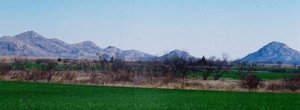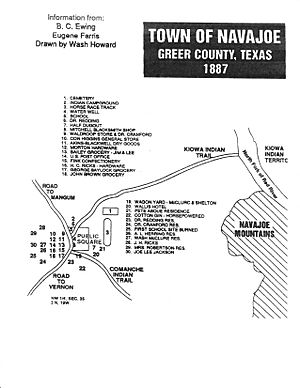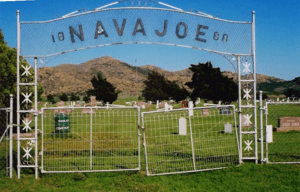Navajoe, Oklahoma facts for kids
Navajoe is a ghost town in Jackson County, Oklahoma, United States. It's located about eight miles east and four miles north of Altus. The town sits right at the base of the Navajo Mountains.
The town of Navajoe got its name from the nearby Navajo Mountains. Local stories say that in the mid-1800s, a group of Navajo people tried to raid the Comanche tribe. They wanted to steal Comanche horses. However, the Comanches stopped them near these mountains.
The Comanches and their friends, the Kiowas, often had conflicts with the Navajos. Raids like this, traveling across the Texas Panhandle, were common back then. Quanah Parker, a famous Comanche chief, told a similar story. He described a Navajo raid on his village around 1848 or 1849. This village was on Elk Creek, just north of the mountains.
Because this raid happened at the same time and place, it likely gave the mountains their name. The town of Navajoe then took its name from these mountains.
In 1886, the area where Navajoe would be was still part of Greer County, Texas. W.H. Acers and H. P. Dale opened a general store there. They chose this spot because it was close to the Western Cattle Trail. It was also near the Indian Reservation at Fort Sill.
The town officially began in 1887. A man named "Buckskin Joe" Works, who promoted land in Texas, came to a Fourth of July picnic. Many settlers, cowhands, and Comanche warriors, led by Quanah Parker, were there. During the celebration, everyone agreed to create an eighty-acre town site. Buckskin Joe would get half of the land lots for helping to promote the town. He did this through his Texas-Oklahoma Colony and a newspaper called the Emigrant Guide. He also organized trips for people interested in moving there.
Also in 1887, Navajoe got its own post office. It was named "Navajoe" to avoid confusion with Navajo, Arizona. That same year, a Baptist church was started. It was the first Protestant church in what would become Oklahoma Territory. In 1888, the Navajoe School opened its doors.
Soon, over 200 families moved to Navajoe and the surrounding area. The town became an important trading spot for settlers, cowhands, and Native Americans. Besides the post office, school, and churches, Navajoe had many businesses. These included grocery stores, hardware stores, saloons, a general store, and a blacksmith shop. There was also a candy store, a dry goods store, a wagon yard, a hotel, and a cotton gin.
The Kiowas traveled to town around the north side of the mountains on the Kiowa Trail. The Comanches came around the south side on the Comanche Trail. Like many frontier towns, Navajoe had some rough times. In 1891, a disagreement over cattle led to a Kiowa chief being killed. This caused some unrest, and families sought safety in town. Soldiers from Fort Sill were sent to help.
In 1902, the railroad was built, but it didn't go through Navajoe. Most businesses decided to move their buildings to the new town of Headrick, which was on the railroad line. In 1920, Navajoe School joined with other nearby school districts.
Today, all that remains of Navajoe is a peaceful, well-kept cemetery. It sits at the foot of the mountains and is still used for burials. In 1976, a granite monument was placed in the center of the cemetery. It shows a map of the old town and honors its history.
Even though the town is gone, the name Navajoe lives on. In 1963, the Friendship and Warren school systems built a new school. It was located halfway between the two towns. This new school, which had its first graduating class in 1964, is still active today. It is called Navajo, but this time without the "e" at the end, to make it easier for the postal service.




